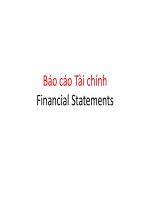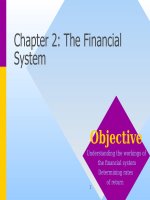Introduc corporate finance ch8
Bạn đang xem bản rút gọn của tài liệu. Xem và tải ngay bản đầy đủ của tài liệu tại đây (839.62 KB, 59 trang )
8-1
Chapter Eight
Strategy and Analysis
in
Corporate Finance
Ross Westerfield Jaffe
Using Net Present Value
•
•
8
Seventh Edition
Seventh Edition
McGraw-Hill/Irwin
Copyright © 2004 by The McGraw-Hill Companies, Inc. All rights reserved.
8-2
Chapter Outline
8.1 Decision Trees
8.2 Sensitivity Analysis, Scenario Analysis, and
Break-Even Analysis
8.3 Monte Carlo Simulation
8.4 Options
8.5 Summary and Conclusions
McGraw-Hill/Irwin
Copyright © 2004 by The McGraw-Hill Companies, Inc. All rights reserved.
8-3
8.1 Decision Trees
•
•
Allow us to graphically represent the alternatives available to us in each period and the
likely consequences of our actions.
This graphical representation helps to identify the best course of action.
McGraw-Hill/Irwin
Copyright © 2004 by The McGraw-Hill Companies, Inc. All rights reserved.
8-4
Example of Decision Tree
Squares represent decisions to be made.
“A”
Study
finance
Circles represent
receipt of information
e.g. a test score.
“B”
“C”
Do not
study
The lines leading away
from the squares
“D”
represent the alternatives.
“F”
McGraw-Hill/Irwin
Copyright © 2004 by The McGraw-Hill Companies, Inc. All rights reserved.
8-5
Stewart Pharmaceuticals
•
•
•
•
The Stewart Pharmaceuticals Corporation is considering investing in developing a drug
that cures the common cold.
A corporate planning group, including representatives from production, marketing, and
engineering, has recommended that the firm go ahead with the test and development
phase.
This preliminary phase will last one year and cost $1 billion. Furthermore, the group
believes that there is a 60% chance that tests will prove successful.
If the initial tests are successful, Stewart Pharmaceuticals can go ahead with full-scale
production. This investment phase will cost $1.6 billion. Production will occur over the
next 4 years.
McGraw-Hill/Irwin
Copyright © 2004 by The McGraw-Hill Companies, Inc. All rights reserved.
8-6
Stewart Pharmaceuticals NPV of Full-Scale
Production following Successful Test
Investment
Year 1
Years 2-5
Revenues
$7,000
Variable Costs
(3,000)
Fixed Costs
(1,800)
Depreciation
(400)
Pretax profit
$1,800
Tax (34%)
(612)
Net Profit
$1,188
Cash Flow
-$1,600
$1,588
4
$1,588
NPV = −$1,600 + ∑
= $3,433.75
t
t =1 (1.10)
Note that the NPV is calculated as of date 1, the date at which the investment of $1,600 million is made. Later we bring this number back to date 0.
McGraw-Hill/Irwin
Copyright © 2004 by The McGraw-Hill Companies, Inc. All rights reserved.
8-7
Stewart Pharmaceuticals NPV of Full-Scale
Production following Unsuccessful Test
Investment
Year 1
Years 2-5
Revenues
$4,050
Variable Costs
(1,735)
Fixed Costs
(1,800)
Depreciation
(400)
Pretax profit
$115
Tax (34%)
(39.10)
Net Profit
$75.90
Cash Flow
-$1,600
$475
4
$475.90
NPV = −$1,600 + ∑
= −$91.461
t
t =1 (1.10)
Note that the NPV is calculated as of date 1, the date at which the investment of $1,600 million is made. Later we bring this number back to date 0.
McGraw-Hill/Irwin
Copyright © 2004 by The McGraw-Hill Companies, Inc. All rights reserved.
8-8
Decision Tree for Stewart Pharmaceutical
The firm has two decisions to make:
To test or not to test.
To invest or not to invest.
Success
Test
Invest
NPV = $3.4 b
Do not
invest
NPV = $0
Failure
Do not
test
McGraw-Hill/Irwin
NPV = $0
Invest
NPV = –$91.46 m
Copyright © 2004 by The McGraw-Hill Companies, Inc. All rights reserved.
8-9
Stewart Pharmaceutical: Decision to Test
•
•
Let’s move back to the first stage, where the decision boils down to the simple question:
should we invest?
The expected payoff evaluated at date 1 is:
Expected Prob.
Payoff
Payoff
Prob.
+
=
×
×
payoff
sucess given success failure given failure
Expected
= ( .60 × $3,433.75) + ( .40 × $0 ) = $2,060.25
payoff
• The NPV evaluated at date 0 is:
NPV = −$1,000 +
$2,060.25
= $872.95
1.10
So we should test.
McGraw-Hill/Irwin
Copyright © 2004 by The McGraw-Hill Companies, Inc. All rights reserved.
8-10
8.3 Sensitivity Analysis, Scenario Analysis,
and Break-Even Analysis
•
•
Allows us to look the behind the NPV number to see firm our estimates are.
When working with spreadsheets, try to build your model so that you can just adjust
variables in one cell and have the NPV calculations key to that.
McGraw-Hill/Irwin
Copyright © 2004 by The McGraw-Hill Companies, Inc. All rights reserved.
8-11
Sensitivity Analysis: Stewart Pharmaceuticals
•
We can see that NPV is very sensitive to changes in revenues. In the Stewart
Pharmaceuticals example, a 14% drop in revenue leads to a 61% drop in NPV
%∆Rev =
$6,000 − $7,000
= −14.29%
$7,000
$1,341.64 − $3,433.75
%∆NPV =
= −60.93%
$3,433.75
• For every 1% drop in revenue we can expect roughly a
4.25% drop in NPV
− 60.93%
4.25 =
14.29%
McGraw-Hill/Irwin
Copyright © 2004 by The McGraw-Hill Companies, Inc. All rights reserved.
8-12
Scenario Analysis: Stewart Pharmaceuticals
•
•
A variation on sensitivity analysis is scenario analysis.
For example, the following three scenarios could apply to Stewart Pharmaceuticals:
1. The next years each have heavy cold seasons, and sales
exceed expectations, but labor costs skyrocket.
2. The next years are normal and sales meet expectations.
3. The next years each have lighter than normal cold
seasons, so sales fail to meet expectations.
•
•
Other scenarios could apply to FDA approval for their drug.
For each scenario, calculate the NPV.
McGraw-Hill/Irwin
Copyright © 2004 by The McGraw-Hill Companies, Inc. All rights reserved.
8-13
Break-Even Analysis: Stewart Pharmaceuticals
•
•
•
Another way to examine variability in our forecasts is break-even analysis.
In the Stewart Pharmaceuticals example, we could be concerned with break-even
revenue, break-even sales volume or break-even price.
To find either, we start with the break-even operating cash flow.
McGraw-Hill/Irwin
Copyright © 2004 by The McGraw-Hill Companies, Inc. All rights reserved.
8-14
Break-Even Analysis: Stewart Pharmaceuticals
•
•
•
The project requires an investment of
$1,600.
In order to cover our cost of capital
(break even) the project needs to throw
off a cash flow of $504.75 each year for
four years.
This is the projects break-even
operating cash flow, OCFBE
N
4
I/Y
10
PV
1,600
PMT
FV
McGraw-Hill/Irwin
− 504.75
0
Copyright © 2004 by The McGraw-Hill Companies, Inc. All rights reserved.
8-15
Break-Even Revenue Stewart Pharmaceuticals
Work backwards from OCFBE to Break-Even Revenue
Revenue
+ VC
Variable cost
Fixed cost
Depreciation
EBIT
+D
+FC
$104.75
0.66
Tax (34%)
Net Income
OCF = $104.75 + $400
McGraw-Hill/Irwin
$5,358.72
$3,000
$1,800
$400
$158.72
$53.97
$104.75
$504.75
Copyright © 2004 by The McGraw-Hill Companies, Inc. All rights reserved.
8-16
Break-Even Analysis: PBE
•
•
•
Now that we have break-even revenue as $5,358.72 million we can calculate break-even
price.
The original plan was to generate revenues of $7 billion by selling the cold cure at $10
per dose and selling 700 million doses per year,
We can reach break-even revenue with a price of only:
$5,358.72 million = 700 million × PBE
PBE =
McGraw-Hill/Irwin
$5,378.72
700 m
= $7.65 / dose
Copyright © 2004 by The McGraw-Hill Companies, Inc. All rights reserved.
8-17
Break-Even Analysis: Dorm Beds
•
•
Recall the “Dorm beds” example from the previous chapter.
We could be concerned with break-even revenue, break-even sales volume or break-even
price.
McGraw-Hill/Irwin
Copyright © 2004 by The McGraw-Hill Companies, Inc. All rights reserved.
8-18
Dorm Beds Example
Consider a project to supply the University of Missouri with 10,000 dormitory beds
annually for each of the next 3 years.
Your firm has half of the woodworking equipment to get the project started; it was bought
years ago for $200,000: is fully depreciated and has a market value of $60,000. The
remaining $100,000 worth of equipment will have to be purchased.
The engineering department estimates you will need an initial net working capital
investment of $10,000.
McGraw-Hill/Irwin
Copyright © 2004 by The McGraw-Hill Companies, Inc. All rights reserved.
8-19
Dorm Beds Example
The project will last for 3 years. Annual fixed costs will be $25,000 and variable costs should
be $90 per bed.
The initial fixed investment will be depreciated straight line to zero over 3 years. It also
estimates a (pre-tax) salvage value of $10,000 (for all of the equipment).
The marketing department estimates that the selling price will be $200 per bed.
You require an 8% return and face a marginal tax rate of 34%.
McGraw-Hill/Irwin
Copyright © 2004 by The McGraw-Hill Companies, Inc. All rights reserved.
8-20
Dorm Beds OCF0
What is the OCF in year zero for this project?
Cost of New Equipment
$100,000
Net Working Capital Investment $10,000
Opportunity Cost of Old Equipment
$39,600 = $60,000 × (1-.34)
$149,600
McGraw-Hill/Irwin
Copyright © 2004 by The McGraw-Hill Companies, Inc. All rights reserved.
8-21
Dorm Beds OCF1,2
What is the OCF in years 1 and 2 for this project?
Revenue
10,000× $200 =
$2,000,000
Variable cost
10,000 × $90 =
$900,000
Fixed cost
Depreciation
100,000 ÷ 3 =
$25,000
$33,333
EBIT
$1,041,666.67
Tax (34%)
Net Income
OCF = $687,500 + $33,333
McGraw-Hill/Irwin
$354,166.67
$687,500
$720,833.33
Copyright © 2004 by The McGraw-Hill Companies, Inc. All rights reserved.
8-22
Dorm Beds OCF3
Revenue
10,000× $200 =
$2,000,000
Variable cost
10,000 × $90 =
$900,000
Fixed cost
Depreciation
100,000 ÷ 3 =
$25,000
$33,333
EBIT
$1,041,666.67
Tax (34%)
Net Income
OCF = $687,500 + $33,333
$354,166.67
$687,500
$720,833.33
We get our $10,000 NWC back and sell the equipment.
The after-tax salvage value is $6,600 = $10,000 × (1 – .34)
Thus, OCF3 = $720,833.33 + $10,000 + $6,600 = $737,433.33
McGraw-Hill/Irwin
Copyright © 2004 by The McGraw-Hill Companies, Inc. All rights reserved.
8-23
Dorm Beds “Base-Case” NPV
First, set your calculator to 1 payment per year.
Then, use the cash flow menu:
CF0
−149,600
CF1
$720,833.33
F1
CF2
F2
McGraw-Hill/Irwin
I
NPV
8
1,721,235.02
2
$737,433.33
1
Copyright © 2004 by The McGraw-Hill Companies, Inc. All rights reserved.
8-24
Dorm Beds Break-Even Analysis
•
•
•
In this example, we should be concerned with break-even price.
Let’s start by finding the revenue that gives us a zero NPV.
To find the break-even revenue, let’s start by finding the break-even operating cash flow
(OCFBE) and work backwards through the income statement.
McGraw-Hill/Irwin
Copyright © 2004 by The McGraw-Hill Companies, Inc. All rights reserved.
8-25
Dorm Beds Break-Even Analysis
The PV of the cost of this project is the sum of $149,600 today less the $16,600 salvage value
and return of NWC in year 3.
CF0
−149,600
CF1
$0
F1
2
CF2
F2
McGraw-Hill/Irwin
I
NPV
8
− 136,422.38
$16,600
1
Copyright © 2004 by The McGraw-Hill Companies, Inc. All rights reserved.









